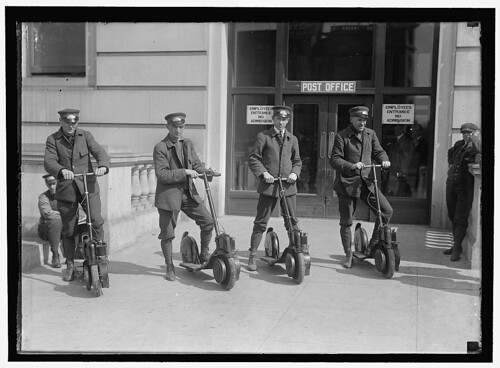
Title-POST OFFICE. POSTMEN ON SCOOTERSIt is unclear where there the above news photograph was taken, other than that it was in a city in the United States. It provides evidence that the idea of commercial uses for powered scooters (here, a small gasoline or perhaps electric motor) is not a new idea.
Contributor Names-Harris & Ewing, photographer
Created / Published-[between 1911 and 1917]
Format Headings-Glass negatives.
Repository-Library of Congress Prints and Photographs Division Washington, D.C. 20540 USA
www.loc.gov/item/2016853758/
With LimeBike introducing eScooter dockless app-driven rentals, one wonders why powered scooters have not been commonly used before. As we now know, scooter-enabled postal delivery did not catch on.

The Segway experiment never went very far, but they are expensive and heavy (clunky) despite a cleverness in design
When Segways appeared more than fifteen years ago, I wondered if they were going to compete with bicycles for traffic space. Their cost and other factors seemed to prevent them from becoming popular with individuals - I see a few being used for city tours in Washington but that is about it. There was one (1!) fellow who I saw for a while using one to commute on the Mt Vernon trail but as an entirely motorized vehicle, it was not legal. The two wheels abreast profile was also not good on this trail that isn't that wide - Segways aren't that fast and getting around him was annoying, and probably stressful for the Segway operator since I don't think putting one wheel off the trail suddenly would be pleasant.
Now we have the LimeBike e-scooters that can be rented for riding around in Washington DC. The LimeBike e-scooters have a substantial 250 watt motor and claim a top steep of just under 15 miles per hour (with the motor alone) which is a pretty good clip for a vehicle that has your feet only five-six inches off the ground and wheels only eight inches in diameter. LimeBike's site refers to the wheels as "solid, stable 8" wheels" but a typical folding bike will have 16 inch wheels (that are real tires, too). The problem with an 8 inch wheel is that a significant pothole or a misjudged curb cut would result in a very sudden stop. While not necessarily a problem if being pushed along with foot power, the results could be a lot more interesting when riding a motorized version.
There is also legal ambiguity, at least for now, as to what rules (if any) a rider of an e-scooter is to follow. The sense one has from LimeBike is that their e-scooters are the same as a bike or e-bike, but isn't obvious why that would be true. Riding one of these on a city street in Washington seems almost crazy by definition, but I can't imagine they are good to have on sidewalks, either. Washington DC in particular has a "no bikes on sidewalks" law for its central business district - https://ddot.dc.gov/publication/dc-central-business-district-no-bike-riding-map-sidewalks-downtown.
If every tenth, or twentieth, person walking in downtown DC was to move to an e-scooter, how would that work?
A separate but related issue is that LimeBike displays a casual attitude towards their vehicles themselves, as things. I can't seem to find a creative commons licences photo of piles of bikeshare bikes in China, but LimeBike and the other dockless bikeshare operators all seem less than concerned about whether some of their bikes end up in effect as random trash (which works for them since they are very cheap bikes). Society, not the operator, will pay for the disposal of a stream of these "vehicles" that may have some convenience for their user-customers but not so much for the rest of us.
Perhaps I am a curmudgeon.
No comments:
Post a Comment